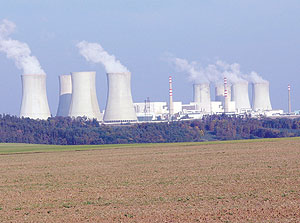Nuclear power has both advantages and disadvantages as compared to other forms of energy. It doesn't depend on fossil and isn't affected by fluctuating oil and gas prices. Coal and natural gas power plants emit carbon dioxide into the atmosphere, which contributes to climate change. With nuclear power plants, CO2 emissions are minimal.


Nuclear power has both advantages and disadvantages as compared to other forms of energy.
It doesn't depend on fossil and isn't affected by fluctuating oil and gas prices. Coal and natural gas power plants emit carbon dioxide into the atmosphere, which contributes to climate change. With nuclear power plants, CO2 emissions are minimal.
According to the Nuclear Energy Institute, the power produced by the world's nuclear plants would normally produce 2 billion metric tons of CO2 per year if they depended on fossil fuels. In fact, a properly functioning nuclear power plant actually releases much less radioactivity into the atmosphere than a coal-fired power plant.
Going by all this comes with a far lighter fuel requirement. Nuclear fission produces roughly a million times more energy per unit weight than fossil fuel alternatives. As for the negatives, mining and purifying uranium hasn't been a very clean process.
Even transporting nuclear fuel to and from plants poses a contamination risk. And once the fuel is spent, you can't just throw it in the city dump. It's still radioactive and potentially deadly. On average, a nuclear power plant annually generates 20 metric tons of used nuclear fuel, classified as high-level radioactive waste.
When you take into account every nuclear plant on Earth, the combined total climbs to roughly 2,000 metric tons a year All of this waste emits radiation and heat, meaning that it will eventually corrode any container that holds it. It can also prove lethal to nearby life forms. As if this weren't bad enough, nuclear power plants produce a great deal of low-level radioactive waste in the form of radiated parts and equipment.
Over time, spent nuclear fuel decays to safe radioactive levels, but this process takes tens of thousands of years.
Even low-level radioactive waste requires centuries to reach acceptable levels. Currently, the nuclear industry lets waste cool for years before mixing it with glass and storing it in massive cooled, concrete structures.
This waste has to be maintained, monitored and guarded to prevent the materials from falling into the wrong hands. All of these services and added materials cost money, on top of the high costs required to build a plant.
As for Nuclear Catastrophe and Reactor Shutdown, we vividly recall the aftermath of the Japanese earthquake and the ensuing tsunami that tore Japan apart and led to its nuclear catastrophe at the Fukushima Daiichi nuclear power Plant and the likes of Chernobyl are some of the known world Nuclear disasters.
For many years, the Chernobyl disaster stood as a prime worst-case example of nuclear malfunction. In 1986, the Ukrainian nuclear reactor exploded, spewing 50 tons of radioactive material into the surrounding area, contaminating millions of acres of forest.
The disaster forced the evacuation of at least 30,000 people, and eventually caused thousands to die from cancer and other illnesses. Chernobyl was poorly designed and improperly operated. The plant required constant human attention to keep the reactor from malfunctioning.
Meanwhile, modern plants require constant supervision to keep them from shutting down. Yet even a well-designed nuclear power plant is susceptible to natural disaster.


